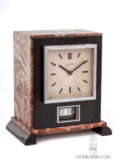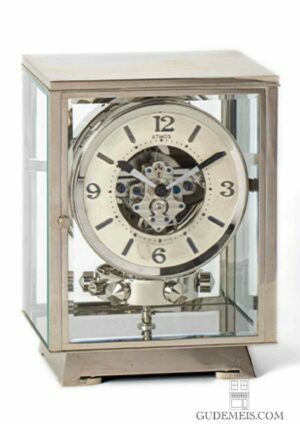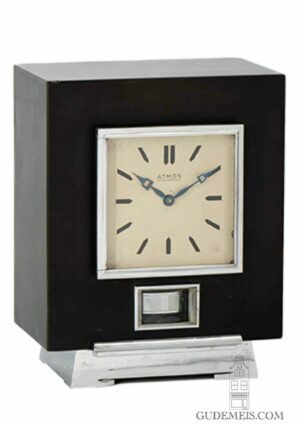A rare French Art Deco marble Reutter patent atmos clock, circa 1930
Description
Reutter Patent Atmos
In 1927 Jean-Léon Reutter created his first prototype clock which driving spring is wound by changes in temperature. After a number of adaptions and improvements a commercial production line of the Reutter patent Atmos was started up in the middle of 1929. There were a number of inventions that made this technical marvel possible. He used a torsion pendulum, known from 400-day clocks, and by enlarging it ensuring a very low ticking count. He made the suspension wire from elivar, an alloy insusceptible to temperature changes, which improved the precision very much. The movement was finely made and executed with ruby end stones causing it to need very little energy. In fact, the clock only needs 1/1000 of the energy that a conventional movement needs. These improvements were combined with his winding mechanism. This consists of a drum which can turn between two blocking pins. In the drum there is a U-shaped glass tube filled with mercury and ammonia gas of which one part is insulated. By changes in temperature and barometric pressure the ammonia gas expands or retracts in comparison to the gas in the insulated half. This causes the mercury to shift which motion turns the drum. This turning winds a spring which drives the mechanism.
Between 1930 and 1938 these clocks were produced under the direction of Reutter. After this period Jaeger leCoultre took over the patent and modified the winding mechanism. The production of the modified Jaeger LeCoultre version commenced after the Second World War. Because of these developments, the number of Reutter patent clocks remained limited. These Reutter clocks were executed with different cases. These Art Deco versions like this marble versions, are fairly rare because they were too modern or avant garde for the large public. Nowadays these clocks are wanted because they fit in any interior and have a timeless quality.
Atmos
The 10-cm dial has baton hour markings and is inscribed ATMOS pendule perpetuelle. The straight hands are made of blued steel.
Pendule perpetuelle
The movement is driven by a spring. This spring is wound by a mechanism which functions on changes in temperature. It causes a drum to turn. This turning motion winds the spring. The exceptional movement requires very little energy to run. With only one degree Centigrade temperature difference, the clock can run for 48 hours. The clock is regulated by a large horizontal balance wheel with adjusting screws which has a thirty second oscillation time. Since there are always changes of temperature during the course of the day, the clock is wound continually and will run continually. That is why Reutter called ‘Pendule perpetuelle’ (perpetual clock).
Art Deco
The rectangular case is made of black and red veined marble. Below the nickel plated door is a nickel lined aperture showing the balance wheel. The geometrical shape of this clock is typical for the Art Deco period. On the reverse is a plaque inscribed with Brevets J.L. Reutter s.g.d.g. made in France.

















